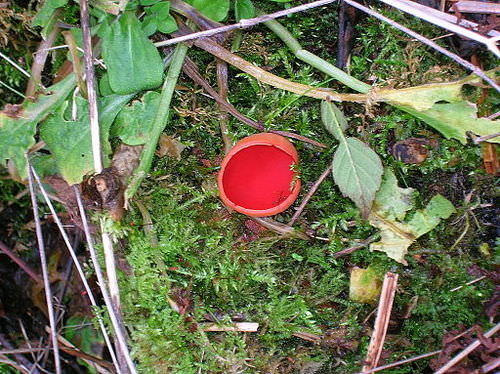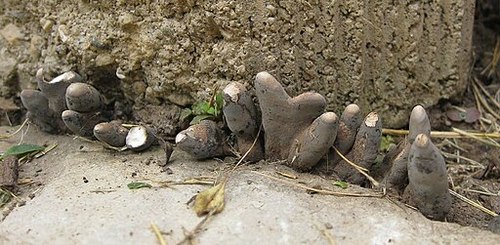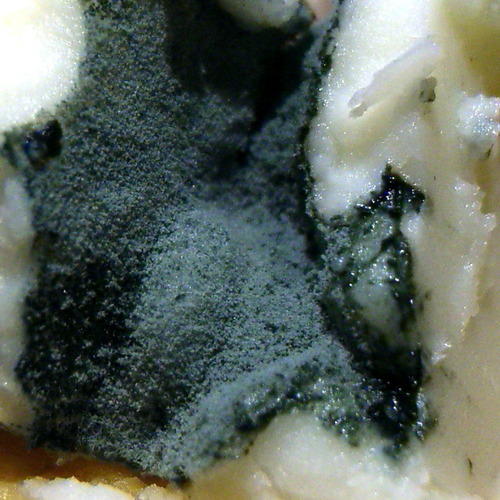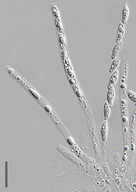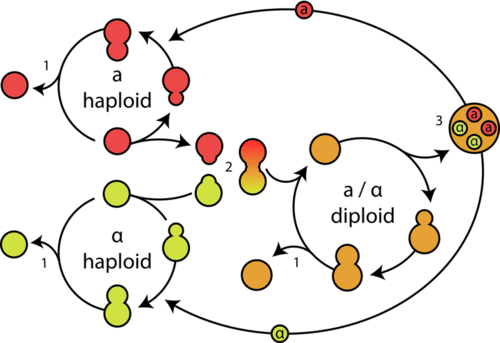12.27 Ascomycota - 高级
章节大纲
-
What's growing on this rock?
::这块石头上长着什么?Can organisms actually grow on rock? Yes, and this one is lichen , a composite organism that results from a mutualistic relationship between a and a cyanobacterium or green . The fungus provides minerals extracted from the rock, and the photosynthetic organisms provides sugars to the fungus.
::生物真的能在岩石上生长吗?是的,而这个是地衣,它是一种复合有机体,产生于一种和一种氰化物或绿色的相互关系。真菌提供从岩石中提取的矿物,而光合生物则为真菌提供糖。Phylum Ascomycota
::吉卜赛人AscomycotaMycorrhizal Fungi and Endophytes
::出血菌菌菌和直肠杆菌Members of the Ascomycota make two important types of mutualistic relationships (where both organisms benefit) with plants: as mycorrhizal fungi and as endophytes. Mycorrhiza are fungi that form symbiotic associations with the root systems of the plants, which are very important for the plant's survival. The mycorrhiza enable the tree to absorb mineral salts from the soil . The fungal partner is able to absorb minerals due to its finely divided mycelium , whilst the plant provides the fungus with metabolic energy in the form of photosynthetic products. It is likely that mycorrhizal associations enabled plants to colonize land; the earliest known of land plants have mycorrhizae.
::Ascomycota的成员与植物建立了两种重要的相互关系(两者都对生物都有益处):作为鼻菌真菌和内分泌物。弥科里萨是真菌,与植物根系形成共生联系,这对植物的生存非常重要。灭科里萨使树木能够吸收土壤中的矿物盐。真菌伙伴能够吸收矿物,因为其细微分割的,而植物则以光合产物的形式为真菌提供代谢能量。很可能,灭科里萨协会使植物得以殖民土地;最早已知的陆地植物有灭菌。Endophytes live inside plants, especially in the and leaves. They do not usually damage their hosts. The exact nature of the relationship between endophytic fungi and their hosts is not yet well understood, but it seems that this form of colonization can give the plant a higher resistance against infection by , (nematodes), and . It can also enable or improve the production of poisonous or bitter alkaloids, which can help a plant avoid being eaten by herbivores .
::植物内部,特别是树叶和树叶中的植物,通常不会损害它们的宿主。对于内科真菌与其宿主之间的关系的确切性质还不清楚,但这种形式的殖民化似乎可以使植物更耐受感染,(肾虫)和。它也可以促成或改善有毒或苦性藻类的生产,有助于植物避免被食草动物吃掉。Sac Fungi
::萨克菌菌Members of the Phylum Ascomycota , shown in Figure , are commonly called "sac fungi." They are distinguished by a distinctive microscopic called an ascus, in which nonmotile spores form. The term "ascus" comes from the Greek word askos, meaning "sac" or "wineskin." The spores that form inside the ascus are called ascospores.
::图中显示的Phylum Ascomycota成员通常被称为“sac fligi ” 。 他们被一个称为“ascus ” 的独特微缩微缩区分开来, 叫做“ ascus ” , 在这种微缩中, 非移动的螺旋形成。 “ ascus ” 一词来自希腊语“ askos ” , 意思是“sac” 或“wieskin ” 。 在“ sacus ” 中形成的“ spores ” , 被称为“ scuspores ” 。The Ascomycota are found in all land world-wide – they even occur in Antarctica. Their spores and hyphal fragments are found in the atmosphere , in fresh , and in saltwater environments. The distribution of individual is very variable: some are found on all continents. In contrast, the white truffle, Tuber magnatum (which is much sought after for culinary purposes), only appears in isolated locations in Italy and France. Parasitic species that infect plants are often restricted by their host distributions.
::阿斯科米科塔(Ascomycota)在全世界所有陆地都能找到 — — 甚至发生在南极洲。 它们的螺旋和催眠碎片在大气、新鲜空气和盐水环境中都发现了。 个人分布非常不同:有些分布在所有大陆都有。 相反,白松露(Tuber Magnatum ) ( Tuber Magnatum,为烹饪目的大量寻找)只出现在意大利和法国的孤立地点。 感染植物的寄主分布往往限制了这些植物的寄主分布。-
Edit here for caption
::编辑此标题 -
Edit here for caption
::编辑此标题
Members of the phylum Ascomycota take on a variety of shapes. (Left) A cup fungus. (Right) Dead man’s fingers (Xylaria polymorpha). Familiar examples of sac fungi include morels, truffles, Baker's yeast, Dead Man's Fingers, cup fungi, and the majority of lichens, called ascolichens. Many plant-pathogenic fungi belong to the Ascomycota. Commonly seen examples include apple scab, ergot, black knot, and the powdery mildews.
::更熟悉的sac真菌的例子包括更多菌、松露、贝克的酵母、死人手指、杯真菌和大多数地衣,称为亚氏菌。 许多植物致病真菌属于Ascomycota。 常见的例子包括苹果刺、黄瓜、黑结和粉状温和剂。However, some members of the Ascomycota do not reproduce sexually. They do not form asci or ascospores. These members are classified as Ascomycota based upon both morphological and physiological similarities to ascus-bearing fungi and also by phylogenetic comparisons of their sequences. Penicillium species on cheeses and in the antibiotic industry are examples of asexual groups. These asexual Ascomycetes are placed in a class called Deuteromycota.
::然而,Ascomycota的一些成员不进行性繁殖,不形成性器官或食肉动物,这些成员根据形态和生理与生菌菌的相似性,以及对其序列的植物遗传学比较,被归类为Ascomycota。Physical Characteristics
::物理特征Many exceptions to the structure described above occur. For example, in the case of Baker's Yeast ( Saccharomyces cerevisiae ), the fungi are single celled yeasts, and there is no mycelium, no fruiting body, and the entire cell is converted into an ascus. In the case of species that are part of a lichen, the stalk (thallus; plural, thalli) of the fungus gives the shape to the symbiotic colony. Other Ascomycota are dimorphic; they can appear either in single or multi-cellular form. Other species have multiple asexual forms as well as a sexual form.
::上述结构有许多例外,例如,在Baker's Yeast(Sachharomyces cerevisiae)的情况下,真菌是单细胞酵母,没有菌类,没有果体,整个细胞被转化成。对于属于地衣一部分的物种,真菌的尾巴(Thallus;复数,thalli)使共生群成为形状。其他的Ascomycota是异形的;它们可以以单细胞或多细胞的形式出现。其他物种则具有多种性形式和性形式。Ascocarps come in many shapes, including cup-shaped, club-shaped, potato-like, spongy, oozing and pimple-like, coral-like, golf-ball-shaped, and cushion-shaped. They can be fleshy, carbonaceous (like charcoal), leathery, rubbery, gelatinous, slimy, powdery, or cob-web-like. They come in multiple colors such as red, orange, yellow, and rarely green or blue, although brown or black are more common.
::木雕以多种形状出现,包括杯形、俱乐部形、土豆类、海绵状、泡泡和小便状、珊瑚类、高尔夫球形和坐垫形。它们可以是肉类、碳类(如木炭 ) 、 皮类、 橡胶类、 胶类、 粘性、 粉类或蜘蛛网形。 它们以多种颜色出现, 如红、 橙类、 黄色, 很少绿色或蓝色, 尽管棕色或黑色更常见。Many ascomatous fungi have the pigment melanin in their hyphal walls and therefore are black or brown. Black spots on bathroom caulking are often colonies of Ascomycetes, such as Cladosporium. Many molds that grow on spoiled foods are ascomycota fungi, as shown in Figure . Except for lichens, the mycelium (if produced) is usually not noticeable because it grows below ground, or it is embedded in the substrate . Only the ascoma is seen (when in season). But spectacular, bizarre, or otherwise noteworthy exceptions occur. Often hyphae have only one per cell and are therefore described as uninucleated, but some ascomycetous fungi can also be multinucleated at times.
::许多长在被宠坏食品上的霉菌,如图所示,许多长在被宠坏食品上的霉菌都是灰色的。除地衣外,菌类(如果生产的话)通常不明显,因为它生长在地下,或嵌入地底。只看到鱼类(当季节时),但出现惊人、奇特或其他值得注意的例外。通常,每间细胞中只有一种,因此被描述为未切除,但有些腐烂的菌类有时也可以多切。The fuzzy growths on this piece of cheese are the thalli and fruiting bodies of ascomycota fungi, most likely a member the genus Penicillium. Metabolism and Nutrition
::新陈代谢和营养Like most fungi, the Ascomycota digest living or dead biomass . To do this, they secrete powerful digestive which break down organic substances into small molecules. The small molecules are then absorbed through the cell wall . Many species live on dead plant material, such as fallen leaves, twigs, or logs. Others attack plants, , or other fungi as parasites and get their metabolic energy, as well as all the nutrients they need, from the cell tissue of their hosts.
::和大多数真菌一样, 阿斯科米科塔消化了活生物量或死生物量。 为了做到这一点, 他们秘密地进行强大的消化, 将有机物质分解成小分子。 小分子随后被吸收到细胞墙上。 许多物种生活在死植物材料上, 如落叶、树枝或木头。 其他人攻击植物, 或其他真菌作为寄生虫, 并从宿主的细胞组织中获取其代谢能量和所需的营养。The Ascomycota also often take up symbiotic relationships – for instance some combine with green algae or cyanobacteria, from which they obtain photosynthetic nutrients, to form lichens. Others form symbioses with tree as mycorrhizal fungi. There are also carnivorous fungi, which have developed hyphal traps to catch small , such as amoebae, as well as roundworms (nematodes), rotifers, tardigrades, and small , such as springtails ( Collembola ).
::亚斯康科塔也常常采取共生关系 — — 比如,有些与绿藻或氰化细菌(cyanoberia)结合,从它们那里获得光合营养素,形成地衣。 另一些则形成共生关系,以树为菌菌菌。 还有食肉菌(conicory fligi),它们开发了催眠陷阱来捕捉小虫,如阿摩巴(amoebae ) 、 圆虫(nematodes ) 、 旋翼虫(rodifers ) 、 缓冲器(tardigrade)和小虫(如春尾(Colembola ) ) 。Through their long evolutionary history, the Ascomycota have developed the ability to break down almost every organic substance. Unlike most organisms, they are able to use their own enzymes to digest plant cellulose and the lignin contained in wood. Collagen and keratin , which are structural in animals, can also be used as food sources. Some Ascomycetes can indeed use very exotic food sources: the Ascomycete Aureobasidium pullulans can metabolize wall paint and the kerosene fungus, Amorphotheca resinae, feeds on aircraft fuel, and, in regions, sometimes blocks fuel pipes.
::通过其悠久的进化历史,Ascomycota已经发展了打破几乎所有有机物质的能力。与大多数生物不同,它们能够利用自己的酶消化植物纤维素和木质。Collagen和Kelatin是动物的结构性结构,也可以用作食物来源。有些Ascomytes确实可以使用非常外来的食品来源:Ascomyte Aureobsacidium Pluulans可以代谢壁漆和煤油真菌、Amorphhotheca 树脂,以飞机燃料为食,有时在地区,可以阻塞燃料管道。Asexual Reproduction of Ascomycetes
::Ascomycetes的性生殖occurs in Ascomycetes by the formation of conidia, which are found on specialized stalks called conidiophores. The morphology of these specialized conidiophores is often distinctive of a specific species and can therefore be used in identification of the species.
::在阿斯科米茨,通过形成共产主义而发生,这种共产主义存在于称为共产主义的专门尾巴上,这些专门共产主义的形态往往与特定物种不同,因此可用于鉴定该物种。Asexual reproduction is the dominant form of in the Ascomycota. In this way, they are able to spread quickly into new areas. Reproduction occurs through reproductive structures, the conidia, which create spores that are genetically identical to the parent and are mostly mononucleated. They are also called "mitospores" because they are formed by . They are generally formed on the ends of specialized hyphae, the "conidiophores." Depending on the species, they may be dispersed by wind, water, or animals.
::在Ascomycota, 性生殖是主要的生殖形式。 这样, 他们就可以迅速扩散到新的地区。 生殖通过生殖结构, 共产体, 创造出与母体基因相同的螺旋, 并且大多是单核的。 它们也被称为“ 微生物” , 因为它们是由 . 它们一般都是由 . . . . . . . . . . . . . . . . . . . . . . . . . . . . . . . . . . 性生殖是通过生殖结构, 共生, 共产性, 产生与母体在遗传上完全相同的螺旋, . . . . . . . . . . . . . . . . 性 . . . . . . . . . . . . . . . . . . . . . . . . . . . . . . . . . 性 . . . . . . . . . . . 性 . . . . . . . . . . . . . 性 . . . . . . . . . . . . . . 性 . . . . . 性 . . . . . 性 . . . . . . . . . . 性 . . . . . . . . . . . . . . . . . . . . . . . . . . . . . . . . . . . . . . 性 . . . . 性 性 性 . 性 . 性 性 . . .Yeasts do not produce spores. Instead, they reproduce asexually by budding . A small bud, or daughter cell , is formed on the parent cell , as shown in Figure . The nucleus of the parent cell splits into a daughter nucleus and migrates into the daughter cell. The bud continues to grow until it separates from the parent cell, forming a new cell. The bud can develop on different parts of the parent cell, depending on the genus of the yeast.
::酵母不产生螺旋。 相反,它们通过萌芽产生性生殖。如图所示,在母细胞上形成一个小芽或女儿细胞。母细胞的核心分裂成女儿核,移入女儿细胞。芽继续生长,直到它与母细胞分离,形成一个新的细胞。芽可以在母细胞的不同部分发展,取决于酵母的基因。Yeasts such as Saccharomyces cerevisiae reproduce asexually by budding. Sexual Reproduction of Ascomycetes
::Ascomycetes的性生殖Apart from exceptions such as Bakers’ Yeast ( Saccharomyces cerevisiae ), almost all fungi of the Ascomycota are haploid ; their nuclei only contain one set of . This makes the fungal DNA prone to . During , there is a diploid phase, but the haploid state is re-established when occurs to create spores.
::除了Bakers ' Yeast(Sachcharomyces cerevisiae)等例外之外,Ascomycota几乎所有的真菌都杂乱无章;它们的核只包含一组。这使得真菌DNA容易被感染。在这种阶段,有一个低潮阶段,但是在出现产生螺旋时,会重新建立无序状态。Sexual reproduction in the Ascomycota is marked by a characteristic structure called the ascus, which distinguishes these fungi from all other fungi. An ascus is a tube-shaped vessel which contains the sexual spores produced by meiosis. The spores that are produced in sexual reproduction are called ascospores, in contrast to the asexual conidiospores.
::在Ascomycota的性生殖中,一个称为“Ascus”的特征结构将这些真菌与所有其他真菌区别开来,“Ascomycota”是一种管状的容器,含有由 meisis 生成的性螺旋,在性生殖中产生的螺旋被称为“食肉动物”,与无性共犯不同。A diagram of an ascocarp, the typical cup-shaped reproductive structure of Ascomycetes. Developing and mature asci are shown along with sterile hyphae, which do not contain ascospores. These asci contain eight ascospores. Formation of Sexual Spores
::性传播的形成The sexual part of the begins when two suitable hyphae meet each other. These come from the same web of hyphae, which can also make asexual spores. The two hyphae must also belong to the same mating type. Mating types are a characteristic of fungi and are similar, in a way, to the sexes in plants and animals. However, one species of fungi may have more than two mating types.
::当两个合适的间歇体相遇时,开始的性部分就来自同一网状的间歇体,这网状的间歇体也可以成为性螺丝。两种间歇体也必须属于同一种交配类型。配方类型是真菌的特征,在某种意义上与植物和动物的性别相似。不过,一种真菌可能具有两种以上的交配类型。In sexual reproduction, two hyphae, a “male” and a “female,” come close together. A very fine hypha grows out of a cell (called a gametangium ) in one of the hypha and towards the gametangium of the opposite hypha. The “female” gametangium cell, called the ascogonium, directs the fine hypha to a gametangium of the “male,” called the antheridium. The nuclei then move from the antheridium to the ascogonium, fertilizing the ascogonium.
::在性生殖方面,“男性”和“女性”两只合二为一。 一种非常细的合二为一的合二为一的合二为一。 一种非常细的合二为一的合二为一的合二为一的合二为一。 一种非常细的合二为一的合二为一的合二为一的合二为一的合二为一的合二为一。 一种“女性”合二为一的“女性”合二为一的合二为一的合二为一的“男性”合二为一的“男性”合二为一。 一种称为“男性”的“男性”和“女性”的“合二为一的合二的合二为一。 一种非常细的合二为一的合二的合二为一。 一种“女性”合二为一的合二为一的合二为一的合二为一。 一种“女合二的合二为一的合二为一。 一种称为“女性 ”合二的“女性”将“女性”将细丁从一个合二的“女性”从一个合二的合一的合一的合二的合二为一的合二为一的合二为一。 。 。 。 一种称为一的合二为一的合二为一的“女性“女性”从一个合二为一的合二为一的合二为一的合二为一的合二为一。 。Next, millions of new dikaryotic hyphae, into each of which two nuclei migrate, grow from the fertilized ascogonium. They are also called ascogenous, or fertile. They are fed by ordinary uni or mononucleate hyphae, which are sterile. The tissue of sterile and fertile hyphae can grow into a visible fruiting body, called the ascocarp (shown in Figure ), which may contain millions of fertile hyphae. Ascocarps are most commonly bowl-shaped but may take on a number of other shapes. The majority of ascomycetous fungi grow as a mass of mycelia.
::其次,数百万新丁基苯丙胺,其中每一颗都有两颗核迁移,从受精的中生长出来。它们也被称为杂质或肥沃。它们由普通的单核或单核氢合金所喂养,它们不育。不育和肥沃的组织可以生长成一个可见的果体,叫做“形”(图中呈现的),它可能含有数百万种肥沃的。形是最常见的碗状,但可能具有若干其他形状。大多数非共性真菌作为弥漫的迷宫而生长。The position of the eight ascospores within the asci of the fungus Hypomyces chrysospermus. In the actual fruiting layer, the asci begin to develop. The asci are formed from diploid cells in the fruiting body (the zygote). The zygote lengthens to form a long tube-shaped capsule : the ascus. Then, meiosis occurs, giving rise to four haploid nuclei, which is usually followed by a further mitotic division of the haploid cells. Each ascus usually ends up with eight daughter nuclei. The nuclei become enclosed by their own membranes and, generally, with a hard cell wall, to form ascospores. The ascospores lie in the asci like peas in a pod, as shown in Figure . Later, when conditions are favorable for growth, the ascospores are released.
::在实际的果质层中, 开始发育。 是由果质体( zygote) 的浸泡细胞构成的。 zygote 长长的螺旋状胶囊形成一个长管状胶囊: ascus 。 然后, 肾上腺素出现, 产生四根胡萝卜核, 通常随之而来的是手动细胞的细微分块。 每个螺旋通常由八个女儿核组成。 核素被它们自己的膜封住, 一般是硬的细胞墙, 形成软骨质。 如图所示, 骨类动物像豆子一样, 藏在一个小舱中的。 稍后, 当条件有利于生长时, 类动物被释放出来。Sexual Reproduction of Yeast
::东部的性生殖Under high stress conditions, haploid cells will generally die. Under the same conditions, however, diploid cells can undergo sporulation, entering sexual reproduction (meiosis) and producing a variety of haploid spores, as shown in Figure . The haploid spores can go on to conjugate, reforming the diploid. This is typical of yeast cells.
::在高压条件下,低压细胞一般会死亡,但是,在同样条件下,低压细胞可以进行发泡、进入性生殖(肝硬化)和产生各种杂交螺旋,如图所示。 低压细胞可以继续相互融合,对低压细胞进行改造。 这是酵母细胞的典型特征。A simple diagram showing a yeast cell. The asexual and sexual lifecycles of yeast. Asexual reproduction by budding or fission is more common (1). In asexual reproduction, a small bud, or daughter cell, is formed on the parent cell. The nucleus of the parent cell splits into a daughter nucleus and migrates into the daughter cell. The bud continues to grow until it separates from the parent cell, forming a new cell. A diploid cell is formed by conjugation (2) of haploid spores. Under high stress conditions, haploid cells will generally die. Under the same conditions, however, diploid cells can undergo sporulation, entering sexual reproduction (meiosis) and producing a variety of haploid spores (3), which can go on to mate, reforming the diploid. Mating requires two opposing mating types, a and alpha. Release of Spores
::Spores的释放The spores of fungi are released in many different ways. Some are spread by wind, and others are spread by water. Certain species have evolved “ spore cannons” which can shoot spores up to 30 cm away. This ensures the offspring fungus will not be in for resources with its parent or “siblings.” Others rely on mechanical force; for example, puffballs can burst when knocked or disturbed. Other fungi attract insects to carry spores away. Stinkhorns attract flies to their fruiting structures by having bright colors and an odor like rotting meat, which flies love. When the spores reach a suitable substrate, they germinate, form new hyphae, and so restart their life cycle.
::真菌的颗粒以多种不同的方式释放出来。 有些是风传播的,另一些是水传播的。 某些物种已经进化了“小火炮 ” , 可以射出螺旋30厘米。 这确保了后代的真菌不会与其母或“子”一起获得资源。 另一些则依赖机械力量;例如,浮球在敲打或扰动时会爆炸。 其他真菌会吸引昆虫把螺旋带走。 其它的真菌会通过光亮的颜色和腐肉的味道吸引苍蝇到其果树结构中,它们像腐烂的肉一样,它们会飞动的爱。 当微菌到达合适的基质时,它们会发芽,形成新的海绵,从而重新开始它们的生命周期。Summary
::摘要-
Members of the phylum Ascomycota are commonly called "sac fungi." They are distinguished by a distinctive microscopic cell, called an ascus, in which nonmotile spores, called ascospores, form.
::Ascomycota植物类成员通常被称为“sac真菌 ” 。 他们被一个独特的微小细胞所区分,这个细胞叫做“Ascus ” , 里面有非移动性的螺丝,叫做“ascus ” 。 -
Some members of the phylum Ascomycota form symbiotic relationships with plants as mycorrhizae or endophytes.
::一些植物的植物组成了同植物的共生关系,植物是灭菌植物或内分泌植物。 -
The Ascomycota are found in all land ecosystems world-wide – they even occur in Antarctica.
::Ascomycota在全世界所有陆地生态系统中都有,甚至发生在南极洲。 -
Asexual reproduction is the dominant form of reproduction in the Ascomycota.
::在Ascomycota,性生殖是主要的生殖形式。
Review
::回顾-
What characteristics define the phylum Ascomycota?
::植物类Ascomycota 是什么特性定义的? -
What is the relationship between mycorrhizae and plants? When did this relationship first develop?
::药草和植物之间的关系是什么?这种关系是什么时候开始发展的? -
What are endophytes and what role do they play in plants?
::在植物中,内分泌物是什么? 它们在植物中扮演什么角色? -
Is it true that ascomycetes only obtain energy by digesting dead organisms or by forming symbiotic relationships with other organisms?
::是否真的只有消化死亡生物或与其他生物形成共生关系,才能获得能量? -
What is the dominant form of reproduction employed by ascomycetes? Describe this process.
::养殖使用的主要生殖形式是什么? 描述这一过程。 -
Describe sexual reproduction in ascomycetes.
::将性生殖描述为青春。
-

